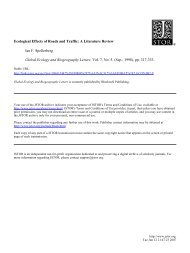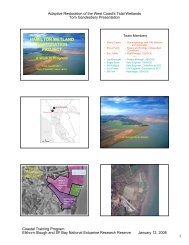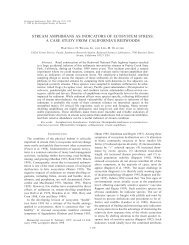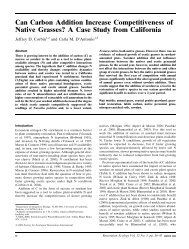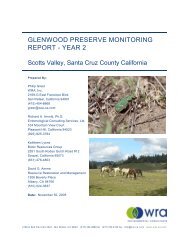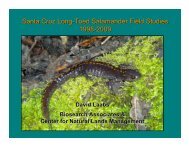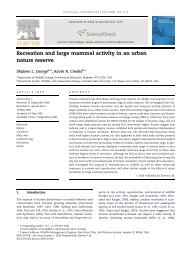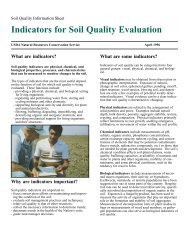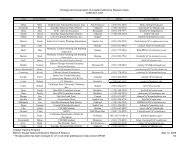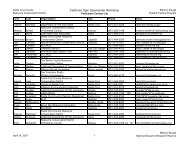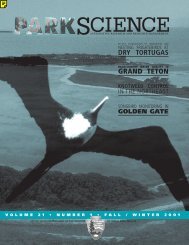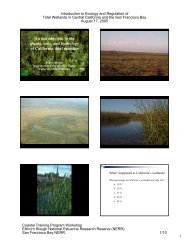ROBERT L. WILKERSON AND RODNEY B. SIEGELFIGURE 14. Probability of detecting owls during the 2006-2007 survey in blocks where owls were detected in1991-1993 as a function of the number of owl pairs detected on the block in 1991-1993. The predicted probabilityof detection in 2006-2007 is shown by the curve. Data points below the curve are blocks on which owls weredetected during both surveys; data points above the curve represent blocks where owls were detected in 1991-1993 but not detected in 2006-2007. Data points are plotted at their 1991-1993 owl pair (x-axis) values andrandomly jittered in the probability (y-axis) space (below or above the curve, depending on whether owls werepresent in 2006-2007) to show the distribution of the data.reliably detect all owls in sampled areas (Conwayand Simon 2003, Conway et al. 2008), particularlyin areas with limited or no road access may tendto bias our estimates low. Additionally, observersgenerally assumed that whenever they detected asingle adult Burrowing Owl, it represented abreeding pair. To the extent that unmated adultbirds may have been detected, this could result inan upward bias in our estimate of breeding pairs.Another potentially confounding factor was thatsurveyors were unable to gain access to somemilitary installations and private landholdings; ifsuch areas were more or less likely to be occupiedby owls than other areas, bias in one direction orthe other could have been introduced into ourestimates. Finally, our survey methodologyincorporated no means for assessing detectionprobability, which in some environments (such asdesert areas with very low road density) mayhave been quite low. Perhaps of even greaterconcern than detection probability being low isthat it could have varied substantially acrosssurvey blocks or survey regions with differentphysiographic characteristics.Nevertheless, we believe the sheer volume ofdata collected counterbalances some of themethodological limitations described above, andensures that the broader patterns in distributionand abundance are meaningful. Additionally,because our methods adhered to thoseestablished by DeSante et al. (2007), any biasesaffecting our results likely affected the 1991-1993study, too, so that comparisons between the twosurveys are appropriate. Finally, our surveydocumented the exact locations of 1,758Burrowing Owl pairs (18.9% of the estimatedtotal) across California, information that shouldbe of great use for ongoing and future conservationefforts.The generally large variances associated withour regional and statewide population estimatesextrapolated from randomly-selected blocksindicate that our statistical power to detectchanges in abundance was rather weak. Indeed,the Northern Central Valley was the only regionfor which our 2006-2007 population estimatediffered significantly from the 1991-1993 estimateof DeSante et al. (2007). Moreover, many of[30]
DISTRIBUTION AND ABUNDANCE OF BURROWING OWLS IN CALIFORNIAour regional “best estimates” were not obtainedby extrapolating data from the randomlyselectedblocks, but rather by simply countingall of the owl pairs that could be found in eitherrandomly-selected or historical breeding blocks.We had no means for assessing statistical significanceof such estimates from the corresponding1991-1993 “best estimates”, many of whichwere generated in the same manner. Nevertheless,inspection of our results, and qualitativecomparisons with results from the 1991-1993survey, still yield some important conclusions.The major patterns in Burrowing Owldistribution and abundance across Californiadescribed by DeSante et al. (2007) have notchanged dramatically since 1991-1993, when thespecies was already extirpated or nearlyextirpated from the San Francisco Bay AreaCoast, Central-western Coast, and SouthwesternCoast regions. The Imperial Valley still accountsfor slightly more than two-thirds of theestimated statewide population, and theSouthern Central Valley remains the secondlargest Burrowing Owl population center.Populations in other regions of the state thatwere surveyed in 1991-1933 all remain muchsmaller than those in the two most heavilypopulated regions.While not statistically significant, we observedapparent declines in two urban areas: SanFrancisco Bay Area Interior Region and theBakersfield area in the Southern Central Valleyregion. The San Francisco Bay Area Interiorregion’s breeding owl population is both smalland well-known by local birders andresearchers, making it very likely that the “bestestimates” from both the 1991-1993 and 2006-2007 surveys reflect very nearly all the owl pairsactually present. Consequently, the apparentloss of 27.9% of the population, from 165 to 119pairs since the early 1990s survey, is somewhatalarming. This loss includes the last known pairsof owls in both Sonoma and San Mateo counties,and suggests that Burrowing Owls have nowbeen extirpated as a breeding species in theentire San Francisco Bay Area, except forAlameda and Santa Clara counties, wherepopulations have also declined. It should benoted that Burrowing Owl populations canfluctuate annually, so our lower count of owls inthe region does not necessarily indicate adeterministic decline. However, the increasinglyrestricted distribution of the species throughoutthe region would seem to indicate that such atrend is real.In the greater Bakersfield area, heavy losses(nine blocks lost a total of 96 pairs) appear to beassociated with recent land conversion fromagriculture to urban, though a finer resolutionspatial assessment would be helpful todetermine whether such land conversion reallyhas driven the losses. In any case, it seems thatlike the San Francisco Bay Area, the greaterBakersfield area is in danger of losing most ifnot all of its once substantial Burrowing Owlpopulation. This is particularly unfortunatebecause the species exhibits a remarkable degreeof tolerance for human alteration of naturalhabitats (Klute et al. 2003, Chipman et al. 2008),often nesting within landfills, golf courses,airports, and vacant lots within urban areas(Haug et al. 1993, Trulio 1997). This tolerance ofhumans and their activities would seem toprovide ample opportunity for successfulconservation efforts, even in the context ofurban areas with growing human populations.One result, showing that the likelihood ofBurrowing Owls persisting through 2006-2007on survey blocks where they were present in1991-1993 was strongly and positively related tothe number of owls that were present on theblocks in 1991-1993, underscores theprecariousness of dwindling urban-areapopulations, and the need for rapid action toprevent local extirpation.In contrast to areas where we noted declines,we also noted areas where Burrowing Owls mayhave increased since the 1991-1993 survey: theCentral-Western Interior region and theCoachella Valley. However, we surveyed a muchgreater number of upland blocks in contrast tothe earlier survey in the Central-Western Interiorregion, so the apparent increase could be anartifact due to increased surveys effort. Incontrast, the apparent increase (from zero to 53owl pairs) in the Coachella Valley seems morelikely to indicate a real increase in owl presence,especially because we found multipleBurrowing Owl pairs on four blocks in theregion that were also surveyed in the early1990s, but yielded no detections at that time.Interestingly, none of the pairs we found inCoachella Valley appeared to be associated withagriculture or water conveyance structures;[31]
- Page 1 and 2: BIRD POPULATIONSA journal of global
- Page 3 and 4: BIRD POPULATIONSA journal of global
- Page 6 and 7: ROBERT L. WILKERSON AND RODNEY B. S
- Page 8 and 9: ROBERT L. WILKERSON AND RODNEY B. S
- Page 10 and 11: ROBERT L. WILKERSON AND RODNEY B. S
- Page 12 and 13: ROBERT L. WILKERSON AND RODNEY B. S
- Page 14 and 15: ROBERT L. WILKERSON AND RODNEY B. S
- Page 16 and 17: ROBERT L. WILKERSON AND RODNEY B. S
- Page 18 and 19: ROBERT L. WILKERSON AND RODNEY B. S
- Page 20 and 21: ROBERT L. WILKERSON AND RODNEY B. S
- Page 22 and 23: ROBERT L. WILKERSON AND RODNEY B. S
- Page 24 and 25: ROBERT L. WILKERSON AND RODNEY B. S
- Page 26 and 27: ROBERT L. WILKERSON AND RODNEY B. S
- Page 28 and 29: ROBERT L. WILKERSON AND RODNEY B. S
- Page 30 and 31: ROBERT L. WILKERSON AND RODNEY B. S
- Page 34 and 35: ROBERT L. WILKERSON AND RODNEY B. S
- Page 36 and 37: ROBERT L. WILKERSON AND RODNEY B. S
- Page 38 and 39: ROBERT L. WILKERSON AND RODNEY B. S
- Page 40 and 41: NIRANJAN DAS AND SUJATA DEORIincluy
- Page 42 and 43: NIRANJAN DAS AND SUJATA DEORIprovid
- Page 44 and 45: NIRANJAN DAS AND SUJATA DEORIpopula
- Page 46 and 47: NIRANJAN DAS AND SUJATA DEORITABLE
- Page 48 and 49: NIRANJAN DAS AND SUJATA DEORITABLE
- Page 50 and 51: NIRANJAN DAS AND SUJATA DEORITABLE
- Page 52 and 53: NIRANJAN DAS AND SUJATA DEORITABLE
- Page 54 and 55: NIRANJAN DAS AND SUJATA DEORITABLE
- Page 56 and 57: NIRANJAN DAS AND SUJATA DEORITABLE
- Page 58 and 59: Bird Populations 10:56-64© The Ins
- Page 60 and 61: WETLAND BIRDS OF GHANAAvicennia afr
- Page 62 and 63: WETLAND BIRDS OF GHANATABLE 1. Data
- Page 64 and 65: WETLAND BIRDS OF GHANATABLE 2: Esti
- Page 66 and 67: WETLAND BIRDS OF GHANAATTUQUAYEFIO,
- Page 68 and 69: JANNIK HANSEN, LARS HOLST HANSEN, N
- Page 70 and 71: JANNIK HANSEN, LARS HOLST HANSEN, N
- Page 72 and 73: JANNIK HANSEN, LARS HOLST HANSEN, N
- Page 74 and 75: JANNIK HANSEN, LARS HOLST HANSEN, N
- Page 76 and 77: JANNIK HANSEN, LARS HOLST HANSEN, N
- Page 78 and 79: JANNIK HANSEN, LARS HOLST HANSEN, N
- Page 80 and 81: JANNIK HANSEN, LARS HOLST HANSEN, N
- Page 82 and 83:
JANNIK HANSEN, LARS HOLST HANSEN, N
- Page 84 and 85:
JANNIK HANSEN, LARS HOLST HANSEN, N
- Page 86 and 87:
JANNIK HANSEN, LARS HOLST HANSEN, N
- Page 88 and 89:
JANNIK HANSEN, LARS HOLST HANSEN, N
- Page 90 and 91:
BIRD POPULATIONSA journal of global
- Page 92 and 93:
Bird Populations 10:90-109© The In
- Page 94 and 95:
DAVID J. ZIOLKOWSKI JR., KEITH L. P
- Page 96 and 97:
DAVID J. ZIOLKOWSKI JR., KEITH L. P
- Page 98 and 99:
DAVID J. ZIOLKOWSKI JR., KEITH L. P
- Page 100 and 101:
DAVID J. ZIOLKOWSKI JR., KEITH L. P
- Page 102 and 103:
DAVID J. ZIOLKOWSKI JR., KEITH L. P
- Page 104 and 105:
DAVID J. ZIOLKOWSKI JR., KEITH L. P
- Page 106 and 107:
DAVID J. ZIOLKOWSKI JR., KEITH L. P
- Page 108 and 109:
DAVID J. ZIOLKOWSKI JR., KEITH L. P
- Page 110 and 111:
DAVID J. ZIOLKOWSKI JR., KEITH L. P
- Page 112 and 113:
Bird Populations 10:110-113© The I
- Page 114 and 115:
THE 2007 AND 2008 NORTH AMERICAN BR
- Page 116 and 117:
Bird Populations 10:114-124© The I
- Page 118 and 119:
BREEDING BIRD CENSUS: 2007on the pl
- Page 120 and 121:
BREEDING BIRD CENSUS: 2007May, with
- Page 122 and 123:
BREEDING BIRD CENSUS: 2007Remarks:
- Page 124 and 125:
BREEDING BIRD CENSUS: 200717. PITCH
- Page 126 and 127:
BREEDING BIRD CENSUS: 2007+; Wester
- Page 128 and 129:
BREEDING BIRD CENSUS: 2008gray Gnat
- Page 130 and 131:
BREEDING BIRD CENSUS: 2008Warbler,
- Page 132 and 133:
BREEDING BIRD CENSUS: 2008Source: W
- Page 134 and 135:
BREEDING BIRD CENSUS: 2008Spotted T
- Page 136 and 137:
BREEDING BIRD CENSUS: 2008precipita
- Page 138 and 139:
Bird Populations 10© The Institute
- Page 140 and 141:
IS AVIAN BREEDING SUCCESS WEATHERIN
- Page 142 and 143:
IS AVIAN BREEDING SUCCESS WEATHERIN
- Page 144 and 145:
DAVE LEECH AND CARL BARIMOREFlycatc
- Page 146 and 147:
Bird Populations 10:143-145Reprinte
- Page 148 and 149:
WOODPIGEON JOINS THE GARDEN PREMIER
- Page 150 and 151:
CHANGING THE GUARD AT UK BIRDTABLES
- Page 152 and 153:
Bird Populations is an entirely ele
- Page 154:
BIRD POPULATIONSA journal of global



